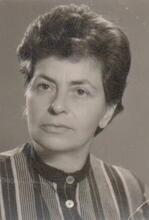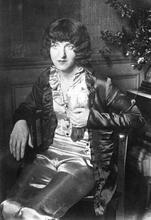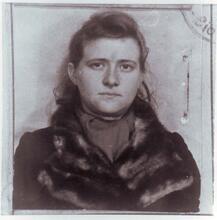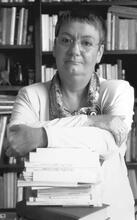Shira Gorshman
A multi-faceted Yiddish writer, Shira Gorshman embodied the vision and struggles of Jewish socialism throughout her long and productive life. Her entry into the world of literature was delayed by her socialist conviction that Jews should work at ordinary labor. Gorshman did not write seriously until the late 1930s in Moscow. She published many works including “Der Mitesser,” 3 Novelen, and Oysdoyer, in Israel and Russia. Gorshman was awarded literary prizes and writing grants including the Dovid Hofshteyn Prize and the Fund for Yiddish Production in Israel. Her work encompassed the shtetl of Lithuania, pioneering Palestine, the Soviet experiment, the Holocaust, and finally the return to modern Israel. In all these journeys her characters—the mothers, toilers, writers, artists—are revealed in their full humanity and individuality.
A multi-faceted Yiddish writer, Shira Gorshman (who also wrote under the names Shirke Goman, Shire Gorman, and Szyrke Gorszman) embodied the vision and struggles of Jewish socialism throughout her long and productive life. She was a passionate and tireless participant in the major social movements of the twentieth century and bore witness in her memoirs and fiction to all their configurations and manifestations.
Early Life and Family
Gorshman was born in Krok (Krakes), a small town near Kovno (Kaunas), Lithuania, to a poor and troubled family. Her father divorced her mother when Shira was an infant because he wanted to become a full-time scholar and could not achieve that status while supporting a family. During World War I the family was evacuated to Odessa where Shira finished elementary school. Forced by her stepfather’s cruelty to leave her mother’s house at the age of fourteen, she found a haven with her beloved grandfather who taught her Tanakh (the Hebrew Bible). While still in her teens, she became a Zionist, married, gave birth to her first daughter, and in 1924 immigrated to Palestine, joining the agricultural collective Gedud ha-Avodah Trumpeldor near Jerusalem. In 1929, following an ideological split, Gorshman, now divorced, returned to the Soviet Union with her three daughters to participate in the development of Jewish agricultural collectives in the Crimea. They lived for three years in the collective, where she managed its dairy farm operation. There she met her second husband, Mendel Gorshman, a visiting graphic artist (who subsequently illustrated several of Shira’s books). In the 1930s they moved to Moscow, where her life brought her into a circle of artists and writers.
Writing Career
Her entry into the world of literature was delayed by her socialist conviction that Jews should work at ordinary labor and not exempt themselves as writers, artists, and academics. Although she began writing at an early age, she did not write seriously until the late 1930s in Moscow, and then only at night while her children slept. In 1937, when the poet Leib Kvitko (1890–1952) saw her unpublished short story “Der Mitesser” (The Fellow-Eater), a mother’s tragic account of brutal poverty, he exclaimed she had earned a place in Yiddish literature on the strength of that story alone. Gorshman included “Der Mitesser” in several collections: 33 Novelen (Warsaw, 1961) and Oysdoyer (Endurance) (Tel Aviv, 1992). Her stories began to appear in journals, Der shtern (Kiev); Der emes (Moscow), and Eynikayt (Moscow), and were included in the anthologies Tsum zig (Towards Victory, 1944) and Heymland (1947). One of her daughters died of starvation in Moscow during World War II.
On her return to Israel in 1990 after an absence of sixty years, Gorshman was embraced by the Yiddish literary establishment. Awarded literary prizes and writing grants including the Dovid Hofshteyn Prize and the Fund for Yiddish Production in Israel, she continued with her prolific creativity well into old age. In Israel she found the freedom and support to recapture the past, including those events she had self-censored in her writing during the years in Russia. Khane’s shuf un rinder (Chana’s Sheep and Cattle), published in 1993, is an unembellished, largely autobiographical novel of collective life in Crimea in the early thirties and of the selfless young idealists who struggled to create a just world beyond the national boundaries of Palestine.
Gorshman’s Powerful Voice
In the memoir In di shpurn fun gedud ha-avodah (In the Wake of the Gedud ha-Avodah, 1988), Gorshman retraces their communal life in Palestine and the Crimea. On a gal (Without Gall), a book of stories, sketches and reminiscences, is a recapitulation: her life with her grandfather, her former communalists, artist and writer friends. This collection, published in 1996, also contains heartfelt tributes to her Israeli editors. Never one to slip into smugness, Gorshman speaks tenderly but critically of her neighbors in the seniors’ residence in Ashkelon where she lived with one of her daughters.
Women’s experience and perspective are central to the terrain Gorshman covered: She depicted both particular and universal social transformations in her/their lives with compassion and keen psychological insight. Integrating historical and personal chronology, her work encompassed the (Yiddish) Small-town Jewish community in Eastern Europe.shtetl of Lithuania, pioneering Palestine, the Soviet experiment, the Holocaust and finally the return to modern Israel. In all these journeys her characters—the mothers, toilers, writers, artists—are revealed in their full humanity and individuality.
Gorshman’s traditional Yiddish is weighted with Jewish and worldly sources: Isaac Leib Peretz (1852–1915), Chekhov and De Maupassant were her literary influences. Her voice, always authentic, is alternately sharp, lyrical, playful, unpretentious. Mirroring the spoken word, her fictive dialogue is vivid, witty, direct. Rare in Yiddish writing: a woman’s capacious life delineated both in the literature of memory and imagination, a reflective and reflected life, lived on the margins and in the center of world-shaping events.
Shira Gorshman died on April 6, 2001, in Ashkelon, Israel.
Der koyakh fun lebn: noveln un geshtaltn ( The Strength of Life: Novellas and Portraits). Moscow: 1948; 33 Noveln Warsaw: 1961.
Lebn un licht: dertseylungen un noveln (Life and Light: Stories and Novellas). Moscow: 1974.
Yontev in mitn vokh: roman, dertseylungen, noveln un rayze bilder (A Holiday in Midweek: A Novel, Short Stories, Novellas, and Travel Scenes). Moscow: 1984.
Oysdoyer: dertzeylungen, noveln, zikhroynes (Survival: Short Stories, Novellas, Reminiscences). Tel Aviv: 1992.
Khanes shof un rinder: roman (Chana’s Sheep and Cattle: A Novel). Tel Aviv: 1993.
Vi tsum ershten mol: novele, dertsylungen, skitzen (Like the First Time: Novella, Short Stories, Sketches), illustrated by Mendel Gorshman. Tel Aviv: 1995.
On a gal: dertsaylungen, skitsen, zikhroynes (Without Gall: Short Stories, Sketches, Reminiscences). Tel Aviv: 1996.
In di shpurn fun “Gedud ha-Avodah” (In the Wake of the “Gedud ha-Avodah”). Tel Aviv: 1998.
“Unspoken Hearts.” In Found Treasures: Stories by Yiddish Women Writers, edited by Frieda Forman et al. Toronto: 1994.
Secondary Sources
Leksikon fun der nayer Yidisher literatur. New York: 1958.
Interview with the author. Ashkelon: January 2, 1995.
Fishkoff, Sue. “A female perspective on shtetl, kibbutz life” (Report on interview with Gorshman and Forman). The Jerusalem Post, January 20, 1995: 14.
Obituary: Forverts, April 13, 2001.









